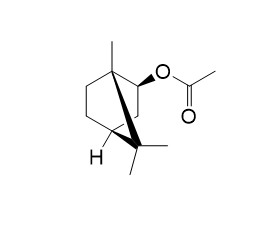Isobornyl acetate
Isobornyl acetate may have sedative effects.
Inquire / Order:
manager@chemfaces.com
Technical Inquiries:
service@chemfaces.com
Tel:
+86-27-84237783
Fax:
+86-27-84254680
Address:
1 Building, No. 83, CheCheng Rd., Wuhan Economic and Technological Development Zone, Wuhan, Hubei 430056, PRC
Providing storage is as stated on the product vial and the vial is kept tightly sealed, the product can be stored for up to
24 months(2-8C).
Wherever possible, you should prepare and use solutions on the same day. However, if you need to make up stock solutions in advance, we recommend that you store the solution as aliquots in tightly sealed vials at -20C. Generally, these will be useable for up to two weeks. Before use, and prior to opening the vial we recommend that you allow your product to equilibrate to room temperature for at least 1 hour.
Need more advice on solubility, usage and handling? Please email to: service@chemfaces.com
The packaging of the product may have turned upside down during transportation, resulting in the natural compounds adhering to the neck or cap of the vial. take the vial out of its packaging and gently shake to let the compounds fall to the bottom of the vial. for liquid products, centrifuge at 200-500 RPM to gather the liquid at the bottom of the vial. try to avoid loss or contamination during handling.
Appl Microbiol Biotechnol.2024, 108(1):207.
Int J Mol Sci.2023, 24(17):13230.
Molecules.2020, 25(9):2111.
Herbal Formula Science2024, 32(2):155-179.
Processes2021, 9(5),831.
Molecules.2021, 26(12):3652.
Nutrients.2021, 13(10):3414.
J. Essential Oil Research2024, 6:36:554-565.
J Ginseng Res.2022, 46(1):104-114.
Molecules.2021, 26(9):2802.
Related and Featured Products
Pharmazie, 1992, 47(8):620-622.
Effects of valerian root oil, borneol, isoborneol, bornyl acetate and isobornyl acetate on the motility of laboratory animals (mice) after inhalation.[Pubmed:
1438515]
METHODS AND RESULTS:
The aromatherapeutical use of commercial valerian root oil (Chinese origin) and of pure fragrance compounds--borneol, isoborneol, bornyl acetate (main constituent of the proved valerian root oil) and Isobornyl acetate--as potentially drugs with sedative effects after inhalation was investigated in an animal experiment (mice).
In additional analyses the mice were treated i.p. by caffeine and distinct sedative effects were observed only by inhalation of the cited substances.
American Journal of Essential Oil and Natural Products,2016,4(2):41-46.
Closely eluting bornyl and isobornyl acetates are chemotaxonomic markers in the Pinaceae by virtue of their unique mass spectra.[Reference:
WebLink]
METHODS AND RESULTS:
Gas chromatography / mass spectrometry (GC/MS) of Abies balsamea, Picea mariana and Tsuga canadensis leaf essential oils assigned bornyl acetate as a major peak in A. balsamea and P. mariana, while Isobornyl acetate was identified as the major peak in T. canadensis. Though these two isomers elute closely on GC, their characteristic mass spectra allow unequivocal structural assignment. Under electron impact (EI) conditions, bornyl acetate, the endo-isomer, displays a significant molecular ion m/z 196, while Isobornyl acetate, the exo-form, displays a marked loss of acetic acid, resulting in a molecular ion an order of magnitude less intense than that of bornyl acetate.
CONCLUSIONS:
Thus GC/MS analyses with authentic standards may be prerequisite for chemotaxonomic studies on Pinaceae essential oils. A re-examination of reports of bornyl acetate in T. canadensis and of Isobornyl acetate in P. abies is suggested.



